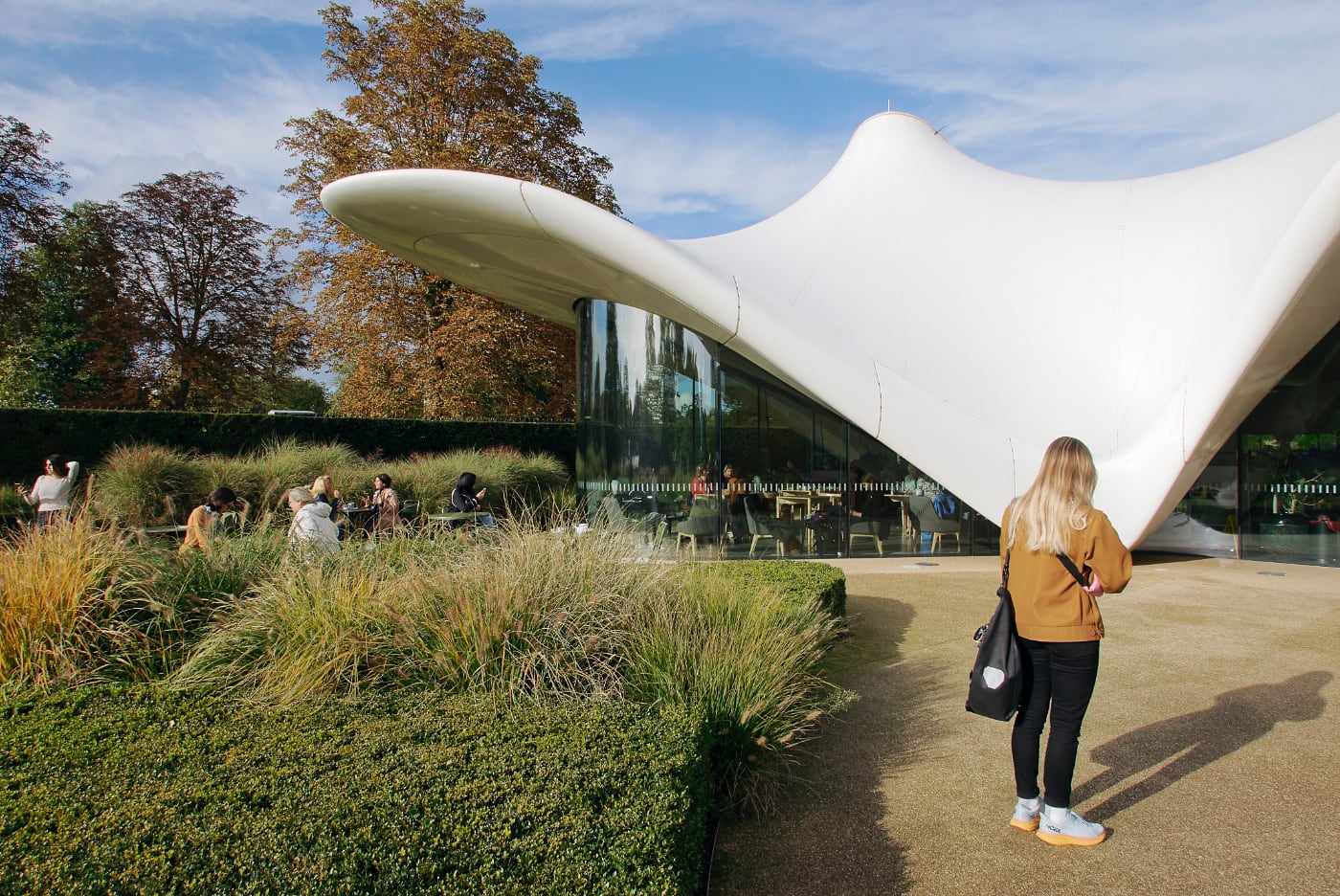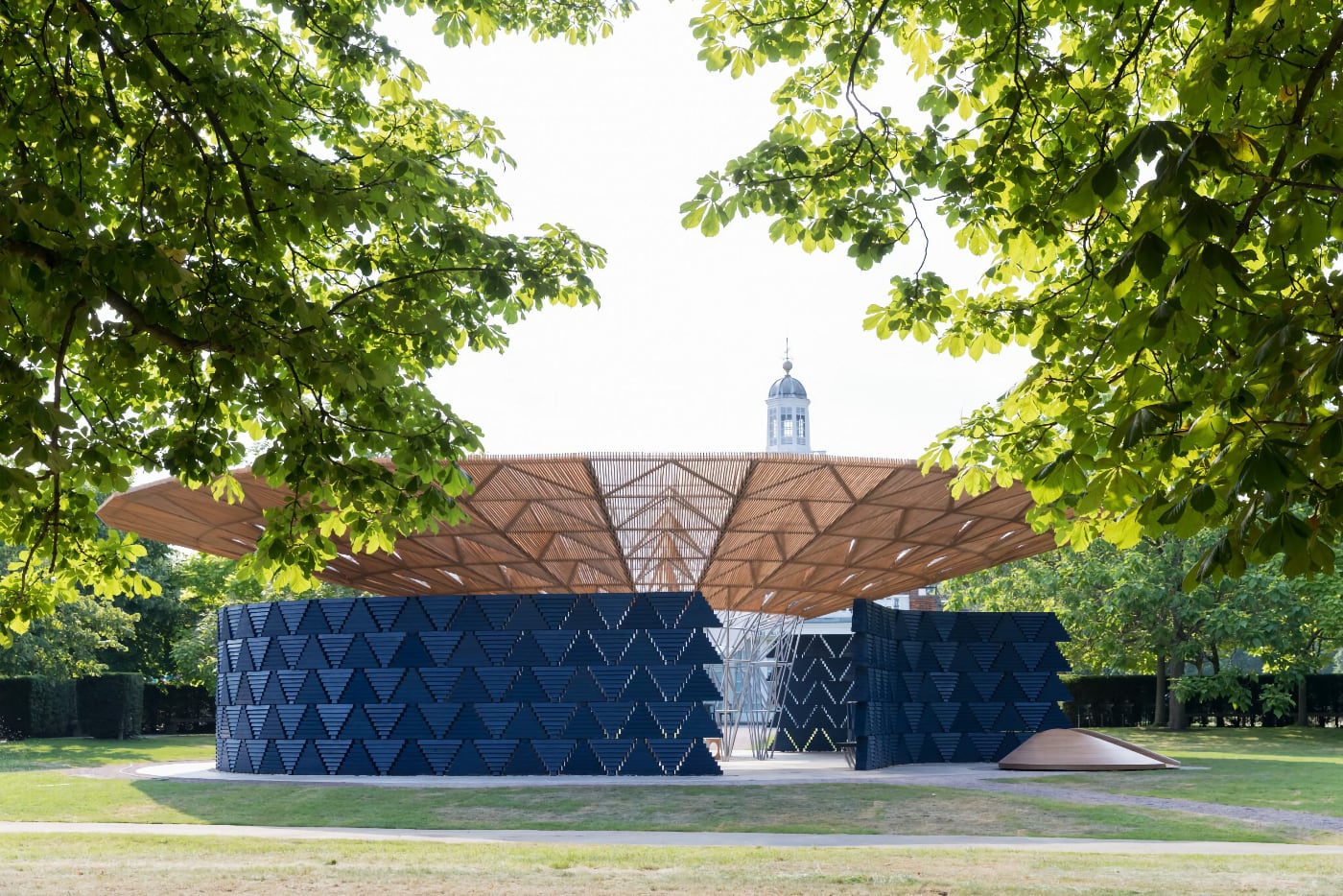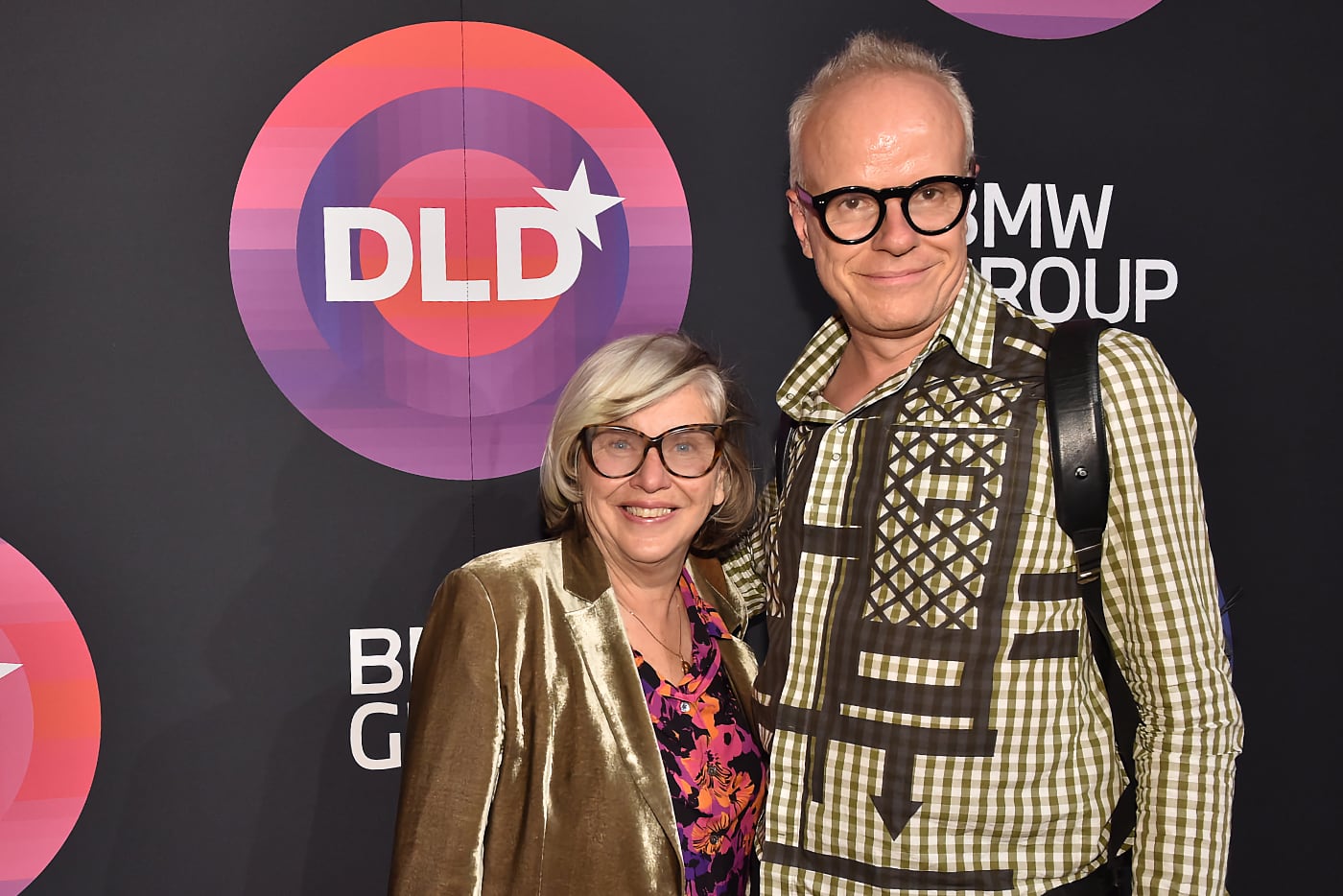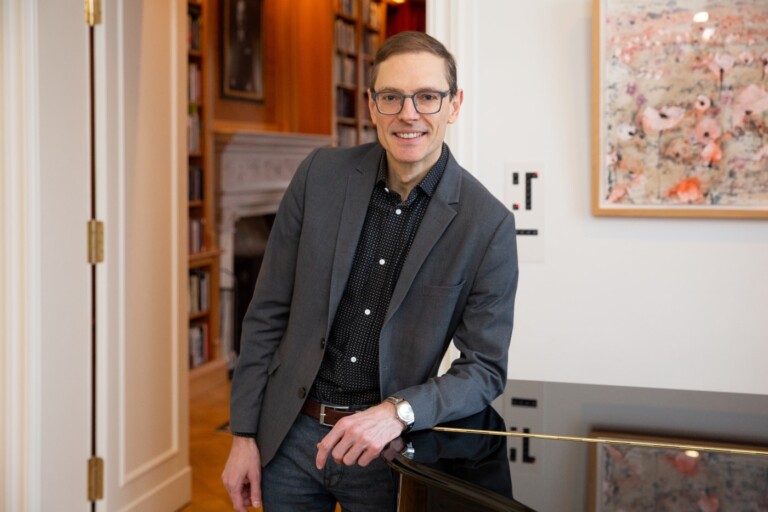
“Art for All, Open to Everyone.” Meet London’s Serpentine Galleries
Get the inside view on one of the world’s leading cultural institutions, as Artistic Director Hans Ulrich Obrist explains Serpentine’s mission and how he came to be DLD’s creative pathfinder as well.
As the sun sets on a cloudy day in London, Hans Ulrich Obrist huddles down in the Serpentine Galleries’ pavilion – a wooden structure, designed by architect Lina Ghotmeh, as open to the autumn chill as the art institute itself is to the world.
Located in Kensington Gardens, Serpentine consists of two separate buildings, connected by a bridge, and is a popular landmark in the city not just for art lovers. Joggers pass by, people walk in, no ticket required, to take a sip of culture, as casually as they order tea or coffee and then sit down for a chat in the cafés that both galleries offer.
The pavilion at the south gallery is an annual art project in itself, and Obrist enjoys the fact that on the last day of this year’s pavilion, visitors come and go while he is speaking with DLD. Some of them wait patiently until the galleries’ Artistic Director has finished, so that they can approach him, politely ask for an autograph or a selfie, to be posted moments later on the World Wide Web.
That’s only fitting. A Swiss-born art lover from the earliest age, Obrist started crisscrossing Europe by train even in his teenage years, always in search of fresh impulses. Today, the 55 year-old is known for embracing technology and spotting developments in society and culture long before they become obvious to the mainstream. His restless search for talent and future projects has earned him the nickname “the curator who never sleeps”.
In conversation with DLD, Obrist explains how he came to be DLD’s cultural pathfinder, how he defines Serpentine’s mission and why he feels that art is essential to society and business – to the point that “every company today should have an artist-in-residence”.
What makes Serpentine stand out?
There are many reasons, I hope, which make them unique. The first thing is, of course, that you always walk through a park in order to arrive at the gallery. There are very few museums which have this connection to nature, to a park, to trees. And I think that’s very, very special. Because the idea is that the park is a common good. It’s one of the most beautiful parks in the world, but it’s really there for everyone, which means everyone can use it for free and enjoy it for free.
How does that influence your work?
There is no admission fee, there are no doors, you can just walk in. You have the joggers, and people come to have a coffee and hold meetings. That’s a very specific thing, this idea of art for all, architecture for all, that it’s there for everyone. Tim Berners-Lee, who invented the World Wide Web in 1989, once told me that his motto for the World Wide Web was always, “This is for everyone.” In an analog way, we have that here, with our exhibitions and pavilions.
What kind of art can visitors expect to see?
We have a very interdisciplinary program. We do art, architecture, design. We think that today, in order to address the big topics and forces in art, we need to break down silos. And as a small, nimble organization we’re in the position to do that. Take our pavilions. Each summer we commission an architect – this year it was Lina Ghotmeh – to design this outdoor space. Initially it was mostly well-known architects like Frank Gehry, Rem Koolhaas or the late Zaha Hadid.
Now we work with younger architects because we realize that this scheme is so established that we can be useful for them. Francis Kéré – who is also a DLD speaker – won the Pritzker Prize soon after doing the pavilion here. Frida Escobedo had built very little outside Mexico and is now doing the new Met building in New York. So in a way it creates visibility for younger architects.
What role does the pavilion play for you?
It’s always here from June to the end of October, and many people in London wonder what’s going to be the next pavilion. It’s almost become a ritual, every year there is a new piece of experimental architecture. People come here all summer and hundreds of thousands of visitors can enjoy this pavilion.
What happens with the pavilions when the summer is over?
The pavilions always have a second life or a third life. They need to live on, many of these pavilions exist elsewhere today. The one by Sou Fujimoto belongs to the Luma Foundation, and Maja Hoffmann lent it to the city of Tirana in Albania. The Frank Gehry one is in the south of France at Chateau La Coste, the one by Smiljan Radic is in Somerset, and the most recent by Lina Ghotmeh is owned by HENI and will be reinstalled in the U.K.
Do you already know what next year’s pavilion will look like?
We are inviting a select group of architects to submit ideas and then we choose one. We are in this process now, but haven’t decided yet. The pavilions over the last couple of years have had a stronger civic dimension, a stronger environmental dimension and a stronger technology dimension – because what makes Serpentine specific is of course the interdisciplinary program: art, architecture, design.

Hans Ulrich Obrist
Serpentine Galleries
“Why don’t museums have a Chief Technology Officer? Museums need a CTO. Everybody else has a CTO in this 21st century.”
Sounds a bit like DLD. How did you come to be the conference’s art director?
The moment Steffi Czerny began DLD in 2005, she asked me to bring art to DLD. And in return I would meet all these technologists. This annual ritual showed me that museums and galleries need to do more with technology. So we started to build a real tech department at the Serpentine because you cannot continue the way museums used to work. Why don’t museums have a Chief Technology Officer? Museums need a CTO. Everybody else has a CTO in this 21st century, so we built a whole department.
What does that mean for artists?
Take the current Gabriel Massan show at Serpentine. This has been produced entirely in-house. We can realize artists’ dream projects with technology. The second department we created is ecology because we worked very closely with the German-English artist Gustav Metzger, who is a legend here in London. He basically came every week to my office and said, “You have to put ecology center stage. You need to make a department, like you did with technology.” That’s why we created an ecology department, and we were the first institution to have an ecology curator. Lots of other museums are going down that route.
Do you see yourself as a trendsetter?
We live in an age where we have a lot of information. It’s exponentially growing, but that does not necessarily mean that we also have more memory. And amnesia might be at the core of this information age, as the late historian Eric Hobsbawm always told me.
So in a way, I think, the role of an art institution is of course to show emerging practices. We’ve done a lot with video games over the last couple of years. Whether it’s a trend – I don’t think that you ever create a trend, but there is clearly a pattern that connects. I like the word pattern better, the idea that we have certain patterns that connect.
Can we say you specialize in early detection?
If you look at video games for example, the phenomenon is really extraordinary. Not only is the video game industry today bigger than the film and the music industry combined, but every third person in the world is in one way or another engaging with video games. And the average age is 34. So this is not just a teenager somewhere in the basement playing video games at night.
How do artists embrace this trend?
Many younger artists are now doing their own video games. It’s almost like the game is the new Gesamtkunstwerk – a comprehensive artwork – because for games you need a story, a soundtrack, there’s animation, there is programming.
You cooperated with Epic Games, maker of the hugely popular video game Fortnite, in 2022. For what purpose?
Serpentine was basically rebuilt as a virtual building on the homepage of Fortnite with the Kaws exhibition that was in collaboration with Acute. They gave us two weeks, and in that time, more than 140 million people saw our show on the Fortnite website.
In addition, many people brought their kids to the gallery – but actually even more so, the kids brought the parents. Normally the parents bring the kids, but here the kids told their parents they wanted to see it. Because they saw it on Fortnite.
This continues now with the Gabriel Massan show. Our CEO Bettina Korek and I with other curators gave a tour, and there was an 8 year-old child who was playing the game. He was there with his mother, and on the big screen you saw how he played. He was very proud because around 100 people were watching him play, and I think that’s a situation you don’t find in many other museums.
Do you see this as a way to keeping cultural institutions relevant?
Yes. It’s not only about patterns that connect – it’s also about finding the new generation. We did a tech project with Jakob Knud Steensen, a Berlin-based game developer and visual artist from Denmark. He collaborated with us and BTS, the hugely popular K-pop band from South Korea. That was also quite extraordinary, because all of a sudden we had a completely new generation of K-pop fans from all over the U.K. who came to the gallery.
I think what is really important is that we build bridges. For me, it’s fundamentally important that we connect art to lots of other fields. it’s not only about bringing people to the gallery, because we always have to know why. The purpose is not just to have crowds in the gallery, there needs to be a mission.

Hans Ulrich Obrist
Serpentine Galleries
“Our mission is to bring art not only to Serpentine, but to bring art into society. Because we are at this moment where we have to pivot. A lot needs to be reinvented.”
Speaking of mission, what is it that you hope to achieve?
One of the core ideas is that the Serpentine Galleries can bring artists into society – because not only are we free admission, there are no doors, people can just walk in. But also that’s not enough, because not everybody is coming to Kensington Gardens. There are many boroughs in London where children grow up who never get in contact with art. So we ask, how we can bring art there?
We’ve worked for example with Barking and Dagenham, which is a London borough with very difficult circumstances for young people. We brought artists-in-residence there and worked with social workers. In a way, the three new dimensions which we have in our program – civic, ecology and also tech – basically enter all the dimensions of our projects.
Why do you feel it’s so important to bring art into society?
Because I really think that we live in a time where a lot of things have to change. We saw during the Covid pandemic how fast society can change if it has to. And maybe the lockdown was a bit of a rehearsal for what we really have to do in order to solve the climate crisis.
The most used word in the corporate world, which I’ve heard from so many CEOs, is that we have to “pivot”. And if you think about this idea of pivoting, who is the master at pivoting? Artists!
This is why I think every company today should have an artist-in-residence. And it’s why I believe our mission is to bring art not only to Serpentine, but to bring art into society. Because we are at this moment where we have to pivot. A lot needs to be reinvented.
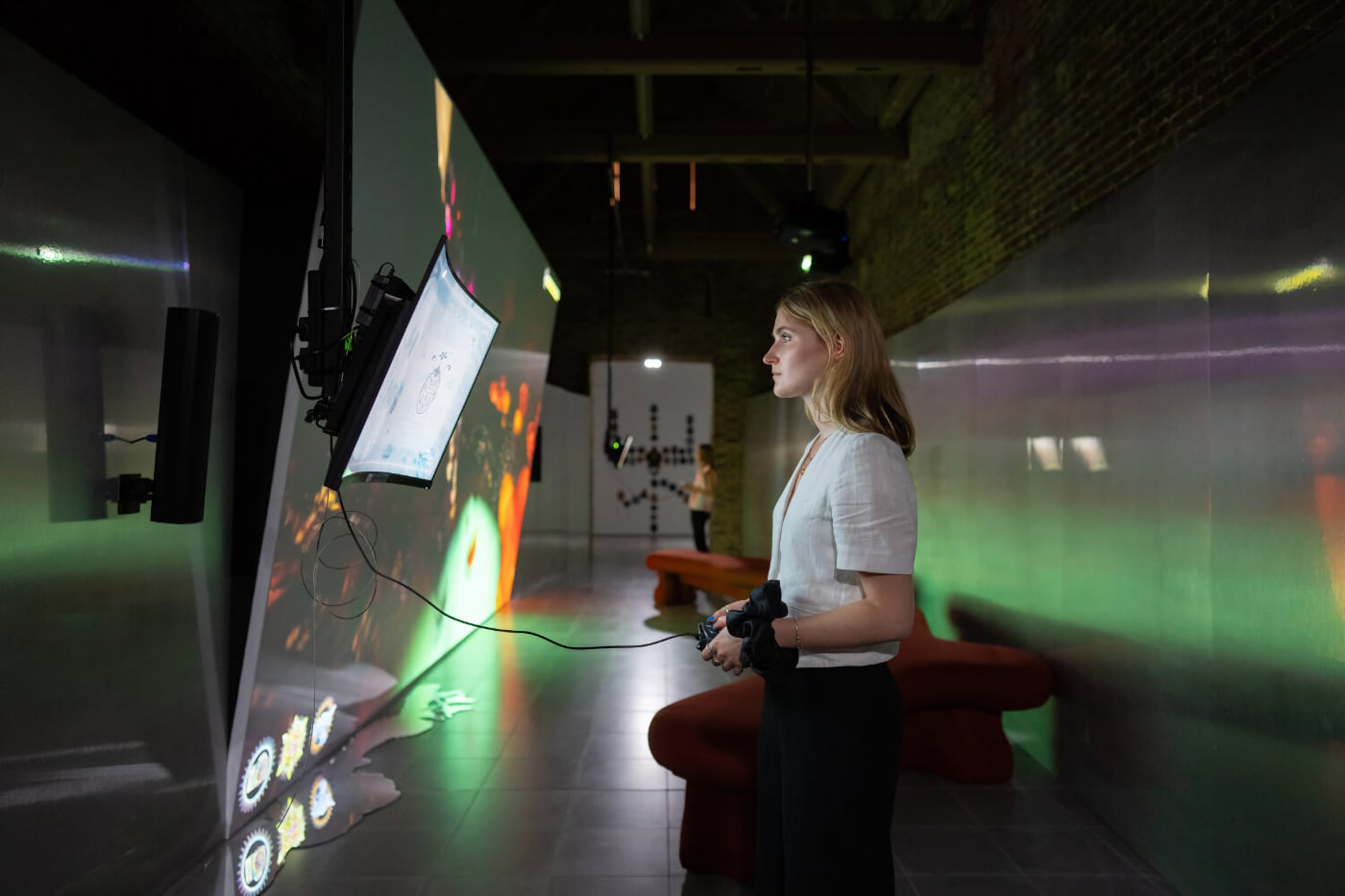
High-tech art: A visitor at the Serpentine North gallery interacts with the exhibition Third World: The Bottom Dimension. (Photo: Hugo Glendinning/Serpentine)
What has the relationship with Bloomberg Philanthrophies done to Serpentine?
Mike Bloomberg is our chairman, and Bloomberg Philanthropies is one of our most important supporters. Bloomberg have developed this amazing app, Bloomberg Connects. If people who read this and want to know more about Serpentine, they can simply download Bloomberg Connects. It’s one of my favourite tools.
Mike Bloomberg came up with the idea of an app where people can access curatorial tours, very special tours, artist voices, art historical knowledge etc. It’s an amazing app that greatly enhances the museum visit. It goes back to the idea that curated tours are for everyone and that audiences should have the opportunity of a museum visit with a curator.
How do you discover the artists that interest you?
It’s a combination of many things. We visit art schools, art fairs and many, many exhibitions, of course. We also speak to artists who mention younger colleagues. But our job is also about making studio visits with very well-known artists to see if there are works that they have never shown.
Take Georg Baselitz, who is, of course, a very well-known artist. If you see these extraordinary wooden sculptures which we’re showing right now – no one has ever seen them. He never wanted to present them publicly. We needed to convince him to show them.
In general, you can make surprising discoveries or rediscoveries. I look at all of that, and the question, ultimately, is always, what is relevant? What is urgent? What transcends our time?
Why do you feel these aspects are so important?
Our society is often stuck in short-termism. I feel we need exhibitions that last longer. And interestingly, a lot of artists now go beyond the idea of exhibition and event culture. With Alexandra Daisy Ginsberg, for example, we worked on her Pollinator Pathmaker project – which is a series of gardens, here in London but also in Cornwall and Berlin.
All of them are planned with the help of AI to maximize biodiversity. The artist uses technology to choose the plants which the pollinators love. So it’s not for us humans – we can still enjoy it, but it’s a garden full of bees and other insects, and it’s a project of several years. Similarly, we’re working now with Yinka Shonibare who built a farm in Nigeria.
So this idea of long-duration, not short-termism, is rseally, really important right now. That’s clearly another pattern that connects.

Hans Ulrich Obrist
Serpentine Galleries
“I feel we live in a world which is very divided. Society needs art in order to create togetherness, love and a common future.”
Do you see any pattern, any connection, between the things you find interesting?
Very often artists take us somewhere where we have never been. I feel we live in a world which is very divided. Society needs art in order to create togetherness, love and a common future.
Why do you think that art has the ability to bring a fractured society together?
One aspect is that art has to do with empathy. But we’re also seeing maybe the most extreme form of globalization in history, where many things becomes homogenized. Take the extinction crisis, the environmental crisis. We can potentially be in touch with each other through our smartphones and all these other technological devices – but at the same time, there is the filter bubble, and there is all this separation and polarization, created by these devices and by social media.
Serpentine has two buildings, north and south. Are you trying to utilize the spaces differently?
There’s a structural difference between the two spaces. First of all, the south gallery is a former tea house from the 1930s. This is a space which has a lot of light coming from the ceiling, and it’s very open to the park. It’s a really fabulous space for painting, for sculpture, for all art forms which need natural light.
The north gallery, across the bridge, is a rather hermetic space, because it’s a former munition depot from Napoleonic times. It stood empty for many, many years until we transformed it into a gallery. We invited the late Zaha Hadid, with whom our pavilion started as well, to redesign it.
We gave her totally free hand with the café, so she made this amazing, almost cathedral-like restaurant space, with these beautiful columns. But inside, the exhibition space, is much more hermetic. It’s a perfect space for moving image and everything we do with new technologies because there’s not much natural light.
There seems to be a nice symbolism as well, because you started at the south gallery and built the bridge into the future by adding the north gallery.
Exactly. And next year, in 2024, we’re going to have two big AI shows at the north gallery with Holly Herndon and Matt Dryhurst, with Refik Anadol, as well as projects with Judy Chicago. At the south gallery, we’re going to do work on shows with Yinka Shonibare, Barbara Kruger and Lauren Halsey.


